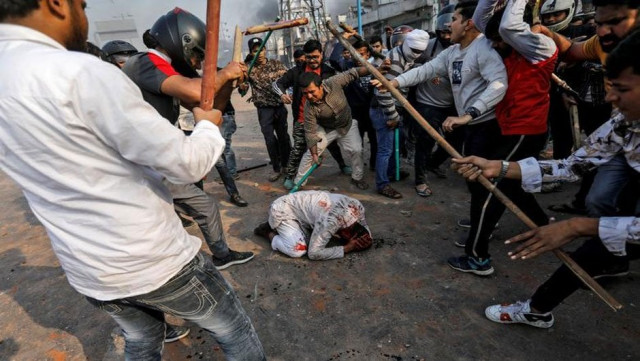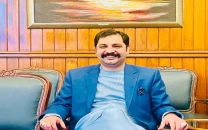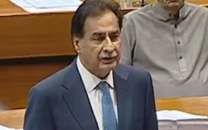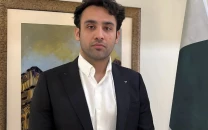The worst place
Problem is not of Muslims, it is about the level of self-harm witnessed in a polity as vibrant and diverse as India

PHOTO: REUTERS
Call it riots or systematic pogrom; this was a long time coming. Two months at the very least. But none of us saw that this would happen right when President Trump was on his way to New Delhi from Ahmedabad — the site of the last major systematic pogrom. It was as if there was a message in this violence. “Don’t pontificate to us. We have the right to hurt our subjects if we so wish and there is nothing you can do about it.” It had been made clear by the US administration that Trump would bring up the matter pertaining to religious freedoms during the bilateral summit. So, this message would come handy. And this had an added benefit for the junta. Once Trump was gone it could claim through optics that Trump was on board. The international press, always in search of more dirt on Trump, would lap it up. That happened too. But if the reports that reached this scribe are correct, this did not sit well with the visiting US President who made his displeasure known during the meetings. When asked for proof to qualify this assertion, I was told that the Indian National Security Adviser (NSA) did not go to the victims of violence and give his word of honour that their lives would be protected just out of the goodness of his heart.
Trump was there to get more business for his countrymen and he managed to do so. That would explain his reluctance to confront the Indian government in public. Consider this: one leader travels over 8,000 miles to ensure more prosperity for his people, the other doles out huge wads of cash to ensure the world and the visiting dignitary do not object to his mistreatment of his own people. And they have the gall to compare Trump and Modi!
Last week, in this space I told you that the Indian government was trying its best to avoid a joint interactive session with the press to ensure Trump did not repeat his offer of mediation on Kashmir in Modi’s presence. This proved correct and New Delhi got its way. But that did not stop Trump from going to the US Embassy and addressing the media there. He even repeated his offer. You should have seen the looks on the faces of those anchors sympathetic to Modi’s worldview. Somewhere in his talk was a reference to the Delhi violence too. This may damage India’s long-term credibility with the man. Remember, no matter how rich you are, if you have infinite ambition like Modi’s cabal does, money to silence people always runs out. The law of diminishing returns.
Let us now return to the Delhi violence. Thanks to the courageous field reporters who went after the truth like moths and also courtesy citizen journalists, a truckload of footage has emerged. There are videos of Delhi Police, which reports to Modi’s Home Minister Amit Shah, destroying the CCTV cameras as the violence went on. Then there are the clips of men, some visibly Muslim, being brutally thrashed by the RSS goons. But one video got to me like nothing else did. A family with women and children is trapped on its roof as the ruling party’s arsonists set the building on fire. The helpless whimpers of kids and the bloodlust of those who would perpetrate such a heinous crime kept flashing before me as I drove back home late at night after spending considerable time on television discussing the Delhi carnage. At one point I had to pull up because the burden of grief was insuperable. I sat there, in the middle of nowhere, until I regained composure.
The problem is not of Muslims (for some reason now being referred to by the Indian right wing as Mohammedans) or of Hindus. It is about human beings and the dramatic level of self-harm witnessed in a polity as vibrant and diverse as India. For decades, the RSS and the BJP have used Pavlovian conditioning to radicalise the more volatile among the majority community and intimidate the moderates and the pacifists. And it just got its wish. Consequently, the country has been reduced to a shell of its former self. This bloodlust will not stop at one community. First Muslims, then Christians, Dalits, and Sikhs — this disease will grow until it has enveloped the entire spectrum.
One example may suffice to highlight the damage done to the institutions. As the violence went on, one brave judge of the Delhi High Court took a courageous stand late at night. Within a day he had been posted out. The erosion of the Indian institutions is complete. The Constitution, the judiciary, the parliament, the media and the executive, one by one, all have been compromised. But do you know what happens when this is done? Since you use jingoism to get there, the path is cleared for intervention by one department that is generally known for its patriotism, discipline — and particularly in the Indian case, secularism — the Indian army. I know it is unheard of. But here is the thing. When you empower one side so much and then allow power vacuums to emerge, the intervention becomes only a matter of time. Perhaps, it may not happen today or tomorrow. But mark my words: it will happen sooner than later and perhaps not for the right reasons.
Published in The Express Tribune, February 29th, 2020.
Like Opinion & Editorial on Facebook, follow @ETOpEd on Twitter to receive all updates on all our daily pieces.



















COMMENTS
Comments are moderated and generally will be posted if they are on-topic and not abusive.
For more information, please see our Comments FAQ